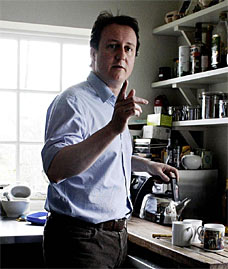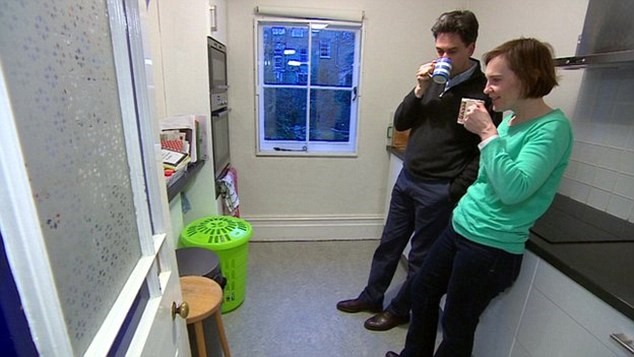
The image of domestic kitchen serves as an electoral asset and reinforces heterosexual gender roles at once.
by Rachael Scicluna
Image: Lawrence JACKSON/THE WHITE HOUSE/AFP/Getty Images
[dropcap]T[/dropcap]he history of the kitchen as a social place, the way we recognise it nowadays, is a very recent understanding in western home practices and rituals. The kitchen is that space which is closest to the body in terms of nurturance, social relations, education, care and processes of feeding. Such processes are often associated with the mother, and her image of the archetypal feeder. The kitchen, also, carries a charged social baggage which includes class, gender, social status, ethnicity, financial and ontological security; and is influenced from the macro level by the economy, the state and its political agenda.
In what follows, I explore the reciprocal relationship between political discourses on family, gender roles, and the role of kitchen-as-hub through British media advertisements. The focus is on how political discourse and policy may inculcate new understandings of gender identity but, equally, set a standard by which citizens ought to live their lives. Such performances may also impact on all those who move away from a traditional domestic setting, including LGBT+ individuals and families, single parents, shared households, and single people.
To address the above complex relationships, I begin by looking at the political shift Britain experienced from the Labour Government (1997–2010) to the Conservative–Liberal Democrat Coalition, with David Cameron who was in political office from 2010 till 2015. The political rhetoric of social reformation and order, adopted by the then British Prime Minister, David Cameron, was largely incorporated in discourses based on family friendly reform agenda in the UKand ‘social reform—bringing security to families who currently have none at all’. Such agendas are further couched within a rationalist economic discourse and at its core lies a new normative family construct based on the dual earner couple.
Much of this political discourse and policy portrays a good family as one which is economically active within the labour market. This political rhetoric raises pertinent observations about the government’s political agenda which perceives the family as the most important thing[s] in our national life. Inasmuch as the latter tries to deconstruct the rigid traditional gendered caregiver and breadwinner dyad, it places the heterosexual couple as the ideal. According to a report by Working Families (2010), “Women make up nearly half of the workforce in the UK and 80% will become mothers during their working life. With the average age of motherhood in the UK being 30, most women at work over this age will also be working parents” (p. 3). Nonetheless, the majority of informal caring in the home is still provided by women, despite the fact that most are in paid labour outside the home.
Moreover, it reinforces the already established domination of hegemonic masculinity which positions alternative work-family practices or lifestyles within a non-normative context. Studies on fathering in the 21st century show how fatherhood is also challenged by this dominant masculinity where fathers who do not fulfil the role of breadwinner are otherised. Additionally, it also privileges the upper-middle-class family over and above the ‘hard’ working-class family. This political discourse on family may also be interpreted as constructing a new type of class, that is, class is transforming into family.

But how does all the above relate to gender, kitchens, class and politics in Britain? Prior to David Cameron being elected as a leader of the Conservative Party in 2006, one of his campaigning tools was the launch of webcameron which sees David Cameron by his kitchen sink, sleeves rolled up and ready to wash dirty cups while tending to his young child. This opening piece introduces Tory politics and policies and, according to Cameron, this is a good way of communicating directly to people by giving them behind-the-scene access. This online performance was a way of projecting himself as an ordinary modern family man fulfilling his duties as a husband, father and politician. This performativity ties in with his political agenda which tries to normalise the intervention of the state and its watchful gaze in the lives of ordinary people. Through this domestic and paternal image in the kitchen, Cameron is sending out a message to society that he understands commitment and familial duties, thus he is the right candidate to be elected. This kitchen image embodies his metaphor of the family as the core of his politics.
His political narrative through the domestic kitchen and that of the paternal image continues into contemporary political campaigning. One of the Daily Mail columns, titled, British Political Leaders are Just Like Us!, shows Michelle Obama happily chatting in the kitchen with Samantha Cameron. First and foremost, the expensive high-technology kitchen gadgets, and super-modern eating areas for the family, assert the importance of class and economic wealth within contemporary society. Secondly, such images reinforce heterosexual gender roles and sexual division of labour that play upon the home–work divide.

This sense of moral duty, as a father, husband and leader is a strategy where the Prime Minister is seeking to instil in the public that he is a homely person and in touch with family life. Eventually, the opposing Labour leader, Ed Miliband used a similar political strategy, right before the 2015 Budget. In a BBC picture reported by the Daily Mail, Ed Miliband and his wife were captured having a cup of tea standing in a cramped cooking space. Eventually, it turned out that the BBC picture was actually his family’s second kitchen. The Independent columnist Kieran Moodly, argued how ahead of the 2015 Budget, the main party leaders clashed over their domestic kitchens.
The messages implicit in this political venture are powerful in relation to gender roles, class, wealth and in constructing an ‘imagined’ future of how a family ought to look like to be secure and successful. The role of the domestic kitchen as a backdrop in these images holds some important social contradictions and uncertainties. Apart from stating and setting the standard of how the ideal kitchen should look like, it indeed struggles to capture the ordinariness of the everyday traditional family.
Also, the expensive high technology kitchen gadgets, and super modern eating areas for the family assert the importance of class and economic wealth within contemporary society. Secondly, such images reinforce heterosexual gender roles and sexual division of labour that play upon the home-work divide. The kitchen becomes a material ensemble displaying status through an ultra-modern sleek design, accompanied by expensive kitchen gadgets, appliances and furniture. However, despite such evident wealth the imagery within these media adverts enhances the domestic role of the British prime minister in the supportive role of husband, father and leader. This is part of the political rhetoric which is crucial in showing a progressive man performing domestic duties which simultaneously sets the ideal image of a traditional (conservative) yet caring husband.

Expensive kitchen appliances and gadgets are technologies of power which are intrinsically part of the global market and become currencies in the exchange market (along with food supplies such as sugar, flour, salt etc.). In obtaining the latest appliances or buying organic, home-grown foods an individual is stating her social status and wealth, which is expressed through a particular taste in style and knowledge. Hence, spectacle becomes an important aspect of maintaining and managing power and class relations. Through such a performative act, an individual is asserting power through their different and distinct kitchen appliances and gadgets, and maintaining it through the presence of her guests. Thus, the ‘heterosexual’ kitchen takes precedence over alternative lifestyles and simultaneously serves as an electoral purpose in attracting women voters, while setting the agenda on how families ought to live and pattern their lives.
To conclude, the ideal representation of the kitchen-as-hub is a symbol of power that belongs to dominant groups, and which has the power to segregate society by gender, class, and status. By identifying the implicit messages embodied within this imagined homogeneous truth, it starts to make sense why David Cameron has chosen to use the domestic kitchen as a backdrop for his electoral campaigning and his political discourse on the family as the blueprint of social cohesion, morality, and order.
![]()
This article is adapted from the monograph, Home and Sexuality: the ‘Other’ Side of the Kitchen (Palgrave Macmillan, 2017).
Leave a Reply